Basisplatten -Design -Beispiel mit eN 1993-1-8-2005, IM 1993-1-1-2005 und EN 1992-1-1-2004
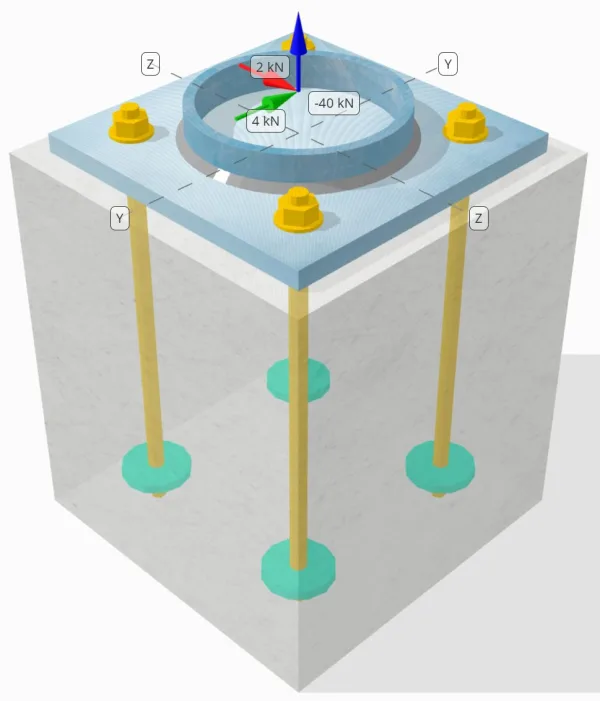
Problemanweisung
Bestimmen Sie, ob die entworfene Verbindung zu Base-Plattenverbindung für a ausreicht 50-kN Zugbelastung, 4-kN Vy Scherlast, und 2-kN Vz Querlast.
Gegebene Daten
Spalte:
Spaltenabschnitt: CHS193.7×10
Säulenbereich: 5770.0 mm²
Säulenmaterial: S460
Grundplatte:
Grundplattenabmessungen: 300mm x 300 mm
Grundplattendicke: 18mm
Grundplattenmaterial: S235
Fugenmörtel:
Fugenmörtel Dicke: 0 mm
Beton:
Konkrete Abmessungen: 350mm x 350 mm
Betondicke: 400 mm
Betonmaterial: C35/45
Geknackt oder ungekrönt: Geknackt
Anker:
Ankerdurchmesser: 16 mm
Effektive Einbettungslänge: 350 mm
Eingebetteter Plattendurchmesser: 70 mm
Dicke eingebetteter Platten: 10 mm
Ankermaterial: 4.8
Schweißnähte:
Schweißtyp: Filet
Schweißnahtgröße: 7mm
Füllmetallklassifizierung: E42
Ankerdaten (von Skyciv -Taschenrechner):
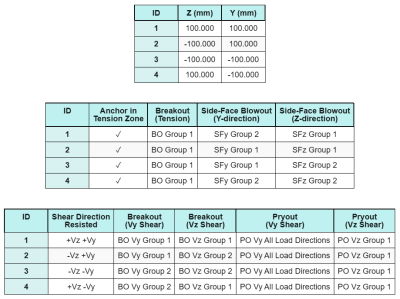
Modell im kostenlosen SkyCiv-Tool
Modellieren Sie noch heute das oben stehende Grundplattendesign mit unserem kostenlosen Online-Tool! Keine Anmeldung erforderlich.
Anmerkungen
Der Zweck dieses Konstruktionsbeispiels besteht darin, die schrittweisen Berechnungen für Kapazitätsnachweise bei gleichzeitiger Scher- und Axiallast zu demonstrieren. Einige der erforderlichen Prüfungen wurden bereits in den vorherigen Entwurfsbeispielen besprochen. Bitte beachten Sie die in den einzelnen Abschnitten bereitgestellten Links.
Schritt-für-Schritt-Berechnungen
Prüfen #1: Berechnen Sie die Schweißkapazität
Das volle Zugbelastung stößt auf Widerstand gesamten Schweißabschnitt, während Scherlastkomponenten verteilen sich nur auf einen Teil der gesamten Schweißnahtlänge. Dieser Anteil wird durch die Projektion von a bestimmt 90° Sektor von der Mitte der Säule bis zu ihrem Umfang. Deshalb, nur die Hälfte des Gesamtumfangs ist so ausgelegt, dass es der Scherbelastung standhält.
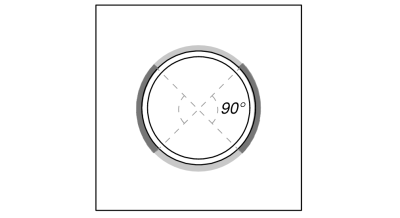
Wir berechnen zunächst die Gesamtschweißlänge und das Teil der Schweißnaht innerhalb der 90°-Projektion.
\(L_{schweißen,voll} = pi d_{col} = pi times 193.7\ \Text{mm} = 608.53\ \Text{mm}\)
\(L_{schweißen} = frac{\pi d_{col}}{2} = frac{\pi times 193.7\ \Text{mm}}{2} = 304.26\ \Text{mm}\)
Als nächstes, wir berechnen die resultierende Scherlast.
\(V_r = sqrt{(V_y)^ 2 + (V_z)^ 2} = Quadrat{(4\ \Text{kN})^ 2 + (2\ \Text{kN})^ 2} = 4.4721\ \Text{kN}\)
Wir berechnen dann die normal und Scherspannungen, unter Berücksichtigung der angenommenen Lastverteilung.
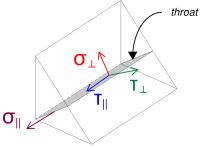
\( \sigma_{\Täter} = frac{N_x}{L_{schweißen,voll}\,a,sqrt{2}} = frac{40\ \Text{kN}}{608.53\ \Text{mm} \mal 4.95\ \Text{mm} \mal sqrt{2}} = 9.39\ \Text{MPa} \)
\( \Ihre_{\Täter} = frac{N_x}{L_{schweißen,voll}\,a,sqrt{2}} = frac{40\ \Text{kN}}{608.53\ \Text{mm} \mal 4.95\ \Text{mm} \mal sqrt{2}} = 9.39\ \Text{MPa} \)
\( \Ihre_{\parallel} = frac{V_r}{L_{schweißen}\,ein} = frac{4.4721\ \Text{kN}}{304.26\ \Text{mm} \mal 4.95\ \Text{mm}} = 2.9693\ \Text{MPa} \)
Danach, wir berechnen die kombinierte Belastungen mit IM 1993-1-8:2005 Gl. (4.1).
\(F_{w,Ed1} = Quadrat{(\sigma_{\Täter})^ 2 + 3\groß((\Ihre_{\Täter})^ 2 + (\Ihre_{\parallel})^2groß)}\)
\(F_{w,Ed1} = Quadrat{(9.39\ \Text{MPa})^ 2 + 3\groß((9.39\ \Text{MPa})^ 2 + (2.9693\ \Text{MPa})^2groß)}\)
\(F_{w,Ed1} = 19.471\ \Text{MPa}\)
Gleichzeitig, Wir bestimmen die Belastung des Grundmetalls mit der gleichen Gleichung.
\(F_{w,Ed2} = sigma_{\Täter} = 9.39\ \Text{MPa}\)
Als nächstes, wir berechnen die Schweißkapazität. Wir ermitteln zunächst die ultimative Zugfestigkeit (das Programm weist Länge zu) des schwächeres Material, und dann verwenden IM 1993-1-8:2005 Gl. (4.1) um die zu erhalten Kehlnahtwiderstand und Beständigkeit gegenüber unedlen Metallen.
\(f_u = \min\!\links(F_{u,\Text{col}},\ f_{u,\Text{bp}},\ f_{u,w}\richtig) = min!\links(550\ \Text{MPa},\ 360\ \Text{MPa},\ 500\ \Text{MPa}\richtig) = 360\ \Text{MPa}\)
\(F_{w,Rd1} = frac{F_U}{\beta_w\,(\Um es zu berechnen{M2,\text{schweißen}})} = frac{360\ \Text{MPa}}{0.8 \mal (1.25)} = 360\ \Text{MPa}\)
\(F_{w,RD2} = frac{0.9\,F_U}{\Um es zu berechnen{M2,\text{schweißen}}} = frac{0.9 \mal 360\ \Text{MPa}}{1.25} = 259.2\ \Text{MPa}\)
Schon seit 19.471 MPa < 360 MPa, Die Schweißkapazität ist ausreichend.
Prüfen #2: Berechnen Sie die Kapazität der Grundplattenflexus aufgrund der Spannungsbelastung
Ein Designbeispiel für die Biegenachgiebigkeit der Grundplatte wurde bereits im Grundplatten-Designbeispiel für Spannung besprochen. Die Schritt-für-Schritt-Berechnung finden Sie unter diesem Link.
Prüfen #3: Berechnen Sie die Betonausbruchkapazität in der Spannung
Ein Bemessungsbeispiel für die Ausbrechfähigkeit des Betons aufgrund von Zugbelastung wurde bereits im Grundplatten-Bemessungsbeispiel für Spannung besprochen. Die Schritt-für-Schritt-Berechnung finden Sie unter diesem Link.
Prüfen #4: Berechnen Sie die Ankerauszugskapazität
Ein Bemessungsbeispiel für die Ankerauszugsfähigkeit wird bereits im Grundplatten-Bemessungsbeispiel für Spannung besprochen. Die Schritt-für-Schritt-Berechnung finden Sie unter diesem Link.
Prüfen #5: Berechnen Sie die Blowout-Kapazität der Seitengesicht in der y-Richtung
Ein Designbeispiel für die seitliche Ausblaskapazität in Y-Richtung wurde bereits im Grundplatten-Designbeispiel für Spannung besprochen. Die Schritt-für-Schritt-Berechnung finden Sie unter diesem Link.
Prüfen #6: Berechnen Sie die Blowout-Kapazität der Seitengesicht in der Z-Richtung
Ein Designbeispiel für die seitliche Ausblaskapazität in Z-Richtung wird bereits im Grundplatten-Designbeispiel für Spannung besprochen. Die Schritt-für-Schritt-Berechnung finden Sie unter diesem Link.
Prüfen #7: Berechnen Sie die Tragfähigkeit der Grundplatte an den Ankerlöchern (Vy Schere)
Ein Bemessungsbeispiel für die Tragfähigkeit der Grundplatte in den Ankerlöchern für Vy-Schub wird bereits im Beispiel für die Bemessung der Grundplatte für Druck und Scherung besprochen. Die Schritt-für-Schritt-Berechnung finden Sie unter diesem Link.
Prüfen #8: Berechnen Sie die Tragfähigkeit der Grundplatte an den Ankerlöchern (Vz-Schere)
Ein Bemessungsbeispiel für die Tragfähigkeit der Grundplatte in den Ankerlöchern für Vz-Schub wird bereits im Grundplatten-Bemessungsbeispiel für Druck und Scherung besprochen. Die Schritt-für-Schritt-Berechnung finden Sie unter diesem Link.
Prüfen #9: Berechnen Sie die Ausbruchkapazität von Beton (Vy Schere)
Ein Bemessungsbeispiel für die Betontragfähigkeit bei Ausbruchversagen aufgrund von Vy-Scherung wird bereits im Grundplatten-Bemessungsbeispiel für Scherung besprochen. Die Schritt-für-Schritt-Berechnung finden Sie unter diesem Link.
Prüfen #10: Berechnen Sie die Ausbruchkapazität von Beton (Vz-Schere)
Ein Bemessungsbeispiel für die Betontragfähigkeit bei Ausbruchversagen aufgrund von Vz-Schub wird bereits im Grundplatten-Bemessungsbeispiel für Scherung besprochen. Die Schritt-für-Schritt-Berechnung finden Sie unter diesem Link.
Prüfen #11: Berechnen Sie die Auspresskapazität
Ein Entwurfsbeispiel für die Betonausbrechkapazität wird bereits im Grundplatten-Entwurfsbeispiel für Scherung besprochen. Die Schritt-für-Schritt-Berechnung finden Sie unter diesem Link.
Prüfen #12: Berechnen Sie die Scherkapazität der Ankerstange
Die Wirkung der Zugbelastung Die Tragfähigkeit der Ankerstange wird bei dieser Prüfung berücksichtigt, wenn die Die Scherkraft wirkt mit einem Hebelarm. Jedoch, in diesem Beispiel, die Scherung wirkt ohne Hebelarm. Deshalb, Die Wechselwirkung zwischen Schub- und Zugspannungen an der Ankerstange wird dabei gesondert bewertet Interaktionsprüfung.
Zur schrittweisen Berechnung der Schertragfähigkeit ohne Hebelarm, Bitte beachten Sie diesen Link.
Die SkyCiv Base Plate Design-Software kann alle notwendigen Prüfungen durchführen, um festzustellen, ob die Scherlast mit oder ohne Hebelarm wirkt. Du kannst Probieren Sie das kostenlose Tool aus heute.
Prüfen #13: Berechnen Sie den Nachweis der Ankerstahlinteraktion
Wir verwenden IM 1992-4:2018 Tabelle 7.3 Gl. (7.54) Um die zu bewerten Wechselwirkung zwischen Scher- und Zugspannungen an der Ankerstange. Durch Einsetzen der Zugspannung und -kapazität sowie der Scherspannung und -kapazität in die Gleichung, das resultierende Interaktionswert ist:
\(ICH_{int} = left(\frac{N_{Ed}}{N_{Rd,s}}\richtig)^ 2 + \links(\frac{V_{Ed}}{V_{Rd,s}}\richtig)^2)
\(ICH_{int} = left(\frac{10\ \Text{kN}}{49.22\ \Text{kN}}\richtig)^ 2 + \links(\frac{1.118\ \Text{kN}}{38.604\ \Text{kN}}\richtig)^2 = 0.042117\)
Schon seit 0.042 < 1.0, Die Prüfung der Wechselwirkung zwischen Stahlversagen der Ankerstange erfolgt ausreichend.
Prüfen #14: Berechnen Sie die konkrete Fehlerwechselwirkungsprüfung
Ein zusätzliches Interaktionsprüfung ist erforderlich für konkrete Misserfolge unter gleichzeitiger Scher- und Zugbelastung. Dafür, Wir verwenden IM 1992-4:2018 Tabelle 7.3 Gl. (7.55) und Gl. (7.56).
Hier sind die resultierenden Verhältnisse für alle Zugprüfungen.

Hier sind die resultierenden Verhältnisse für alle Scherprüfungen.

Zuerst, Wir prüfen mit Gl. (7.55) und vergleichen Sie das Ergebnis mit dem maximale Interaktionsgrenze von 1.0.
\(ICH_{\Text{Fall1}} = left(\links(\frac{N_{Ed}}{N_{Rd}}\richtig)^{1.5}\richtig) + \links(\links(\frac{V_{Ed}}{V_{Rd}}\richtig)^{1.5}\richtig)\)
\(ICH_{\Text{Fall1}} = left(\links(\frac{40}{45.106}\richtig)^{1.5}\richtig) + \links(\links(\frac{4.1231}{14.296}\richtig)^{1.5}\richtig) = 0.99\)
Als nächstes, Wir prüfen mit Gl. (7.56) und vergleichen Sie das Ergebnis mit dem maximale Interaktionsgrenze von 1.2.
\(ICH_{\Text{Fall2}} = frac{N_{Ed}}{N_{Rd}} + \frac{V_{Ed}}{V_{Rd}} = frac{40}{45.106} + \frac{4.1231}{14.296} = 1.1752\)
Schon seit 0.99 < 1.0 und 1.175 < 1.2, bleibt die Prüfung der Wechselwirkung zwischen konkreten Fehlern ist ausreichend.
Entwurfszusammenfassung
Mit der Skyciv Base Plate Design Software kann automatisch einen Schritt-für-Schritt-Berechnungsbericht für dieses Entwurfsbeispiel erstellen. Es enthält auch eine Zusammenfassung der durchgeführten Schecks und deren resultierenden Verhältnisse, Die Informationen auf einen Blick leicht zu verstehen machen. Im Folgenden finden Sie eine Stichprobenzusammenfassungstabelle, Welches ist im Bericht enthalten.
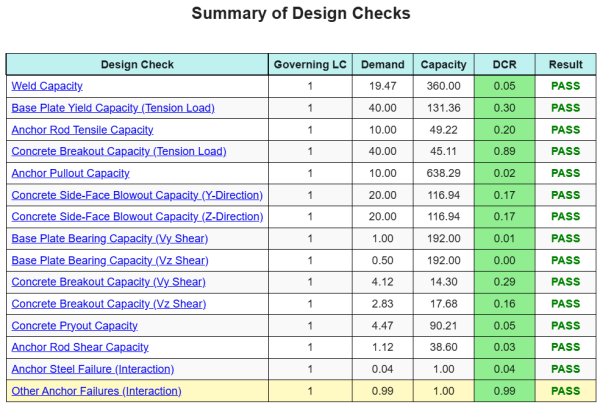
SKYCIV -Beispielbericht
Sehen Sie sich den Detaillierungsgrad und die Klarheit an, die Sie von einem SkyCiv-Grundplatten-Designbericht erwarten können. Der Bericht umfasst alle wichtigen Designprüfungen, Gleichungen, und Ergebnisse werden in einem klaren und leicht lesbaren Format präsentiert. Es entspricht vollständig den Designstandards. Klicken Sie unten, um einen Beispielbericht anzuzeigen, der mit dem SkyCiv-Grundplattenrechner erstellt wurde.
(Beispielbericht wird bald hinzugefügt)
Basisplattensoftware kaufen
Kaufen Sie die Vollversion des Basisplatten -Designmoduls selbst ohne andere Skyciv -Module selbst. Auf diese Weise erhalten Sie einen vollständigen Satz von Ergebnissen für die Basisplattendesign, Einbeziehung detaillierter Berichte und mehr Funktionen.


